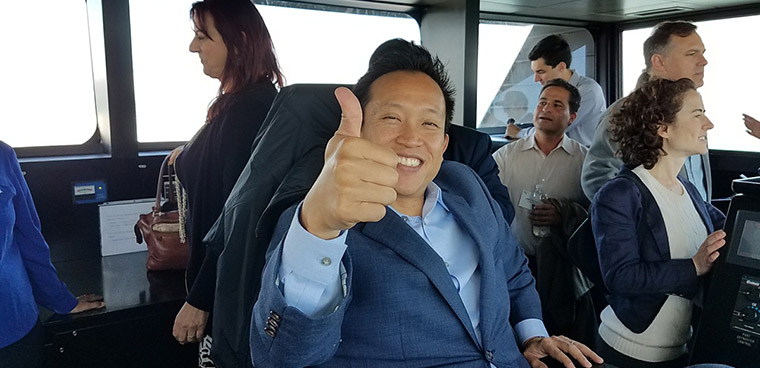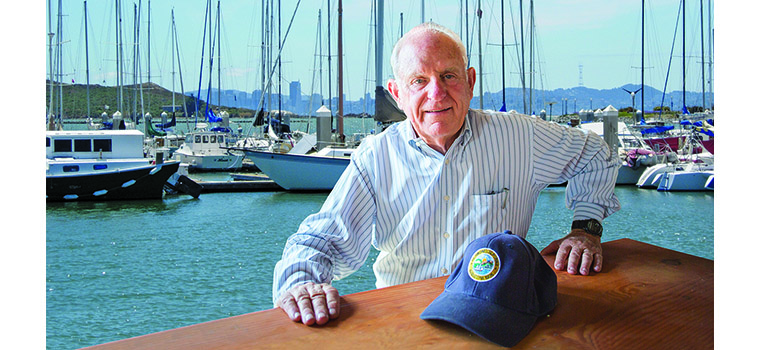Over the last few months, Bay Crossings has discussed the importance of passing Regional Measure 3 (RM3), which will appear on the upcoming June 5 ballot.

State Assemblymember David Chiu of San Francisco emphasized emergency preparedness as a primary concern for maintaining and expanding ferry service. Photo by Bobby Winston
BC STAFF REPORT
Published: May, 2018
Over the last few months, Bay Crossings has discussed the importance of passing Regional Measure 3 (RM3), which will appear on the upcoming June 5 ballot. This month we feature comments from public officials at all levels of government—all of whom are in favor of this critical step in bringing infrastructure improvements and increased transportation capacity to the Bay Area.
RM3 is the result of collaborative efforts by the nine Bay Area counties to identify comprehensive traffic relief projects that can be quickly deployed to bring much-needed solutions to congested roadways and overburdened transit systems. The measure would modestly increase tolls on the region’s seven state-owned toll bridges to fund these crucial traffic relief projects throughout the Bay Area. Polling shows that traffic is second only to housing in voter concerns, and one of the greatest threats to the economic vitality of the region.
In early April, U.S. Senator Dianne Feinstein shared her endorsement of RM3 during a 45-minute “fireside chat” attended by more than 320 Bay Area business leaders and students. In addition to other high-profile national issues, Senator Feinstein discussed the many challenges facing the Bay Area and the region, highlighting the valuable transportation and transit improvements that RM3 will support.
Addressing the region’s growing congestion problems and insufficient infrastructure, Feinstein said, “California leads the nation in many areas; traffic congestion shouldn’t be one of them. I believe Regional Measure 3 is a critical step toward improving our region’s transportation network. Less time spent in traffic, more transit options and improved infrastructure are vital to the region’s economic growth and keeping the Bay Area moving forward.”
The nine-county region of Alameda, Contra Costa, Marin, Napa, San Francisco, San Mateo, Santa Clara, Solano and Sonoma will need a majority of voters to approve RM3 to support the crucial and practical highway and transit improvements in June. Feinstein joins over 140 elected and appointed officials, over 35 organizations and 64 community stakeholders who have already endorsed RM3.
Assemblymembers Bonta and Chiu Talk RM3
Bay Crossings interviewed Assembly-member Rob Bonta of Alameda/Oakland and Assemblymember David Chiu of San Francisco regarding RM3. Ferries are of particular interest to their communities in San Francisco and Oakland/Alameda, both to get people to work and as key elements in the region’s emergency preparedness plan:
BC: What do you look for RM3 to provide for your respective districts in San Francisco and Oakland/Alameda?
David Chiu: At the top of that list will be improvements for our city’s overloaded Muni and the region’s BART systems. Emergency preparedness is also a primary concern for San Francisco, so for that reason, as well as the economic benefits they confer, I also secured substantial improvements to regional ferry service. In particular, I’d like to see progress opening up water transit service connecting the Peninsula to the Ferry Building and other parts of the San Francisco waterfront. I am also interested in plans to improve and beautify the ferry landings behind the Ferry Building, because the “front door” to our city simply needs to look better.
Rob Bonta: Part of what makes RM3 so critical is that currently, ferry funding is either from RM2 or fare box recovery, and, unlike AC Transit and BART, there’s no federal, state or even parcel tax funding sources for ferries. Any funds provided by RM3 will come from increased tolls paid by commuters, like those living in the East Bay. Making sure my constituents are served and their needs are met is my top priority.
But there are a few immediate opportunities I see here with RM3.
The East Bay is well positioned for future job and housing growth in that it has room to grow, especially in the former Alameda Naval Air Station, where over 9,000 jobs will be created. Ferry ridership increased 71 percent between 2012 and 2015, and more funds are needed to meet the demand. Alameda’s proposed Seaplane Lagoon ferry service would add 20-minute ferry rides between Alameda and San Francisco—increasing transbay capacity without adding trips to BART or the Bay Bridge.
In addition to being critical to transportation in our districts, ferries are also an important source of jobs. I am very proud of Bay Ship and Yacht’s work in my district employing citizens who are re-entering their communities after incarceration as part of their “Working Waterfront Cohort” partnership with the College of Alameda. And I’m confident we can build on this model. Let’s explore and invest in projects that keep repairs and upkeep here in the Bay Area, like we do with AC Transit.
As Assemblymember Chiu men-tioned, and I agree, ferry service also plays an important role in coordinating transportation response for natural disasters and emergencies or network disruptions such as scheduled and unscheduled road/bridge or BART closures. That’s critical and is at the heart of RM3. And I agree, BART also needs our support.
I also want to mention something in particular that we need to be strategic about: parking. So many of my constituents in Alameda are doing the right thing by taking public transit via ferry, but some have to walk up to a mile from where they have to park. We must look at alternatives to driving to the ferry terminals. Part of solving this parking problem could involve a shuttle for the island community of Alameda modeled on the successful Emery Go-Round [free shuttle service in Emeryville], or water taxis as an option for crossing the estuary between Oakland and Alameda to lighten the burden on the Posey Tube and bridges. I expect RM3 can and will help with all of these priorities.
Richmond Mayor Tom Butt Discusses RM3
Bay Crossings also sat down with Mayor Tom Butt of Richmond to get his thoughts on RM3:
BC: Why does RM3 matter for Richmonders?
Mayor Butt: It matters a lot and in many different ways. I know Bay Crossings is concerned with ferry service and it’s indeed the case that RM3 will be critical to ensuring the long-term sustainability of the ferry service that is finally coming to Richmond in just a few months. But there are key other projects teed up for RM3 funding that matter just as much, for example Capitol Corridor train service and clearing up congestion at the Richmond-San Rafael bridge.
BC: How do Richmond and Contra Costa feel about RM3?
Mayor Butt: Remember, RM3 is a bridge toll increase, and that means voters from Contra Costa and Alameda counties are disproportionately affected because that’s where the most bridges are. That’s why my fellow leaders and I bargained hard for the projects that matter to us. It was touch and go there for a while, but in the end I’m satisfied that we are getting our fair share.
BC: What do you think will be the long-term effect of RM3?
Mayor Butt: Well, everyone knows traffic is a nightmare, and that we have put off maintenance of our transit network, not to mention failed to build the new capabilities we need to keep up with growth. We feel it acutely here in Richmond where traffic bottlenecks at the Richmond-San Rafael Bridge and I-80 are a huge problem. RM3 is about as big a step in the right direction for dealing with these problems as I’ve seen in a while.
In the longer view, the kinds of priorities included in RM3 are long overdue and a most welcome shift in thinking when it comes to transit. I’m thinking of things like the bike path on the Richmond-San Rafael Bridge, Bay Trail improvements and the Smart Train in the North Bay. I even envision a time when we recreate the ferry and even train link between Richmond and Marin.
Other Officials Offer Their Support for RM3
Several other public figures have made public comments in favor of RM3. We round out our coverage with two comments from Oakland’s Mayor Libby Schaaf and San Francisco mayoral candidate Jane Kim:
“This measure will pave the path for transportation improvements throughout Alameda County, including alleviating congestion on Interstate 880, the Dumbarton Bridge, and improvements to AC Transit and BART,” said Oakland Mayor Libby Schaaf. “The funding generated by RM3 is especially critical for investments in Oakland, which is a vital transit hub for travelers by rail, ferry, bus and car.”
“San Francisco is a city focused on the future, but much of our transportation infrastructure is stuck in the past,” said San Francisco Supervisor Jane Kim. “The improvements made possible by RM3 are key to growing capacity, increasing transit options and improving the lives of our residents, commuters and visitors.”
RM3 will be an opportunity to fund badly-needed transit infrastructure improvements through a boost in bridge tolls, and the plan includes significant new support for ferry service and capacity increases. We will conclude our coverage next month with a full review of the measure and why it is so desperately needed.
For more information about RM3 and the Yes on RM3 coalition visit www.yesonrm3.com.

Passage of RM3 is critical to the future of Bay Area ferry service. RM3 will provide $300 million of new capital and up to $35 million of annual operating revenue to help rapidly build out the system and advance WETA expansion plans. Photo by Toby Harriman Photography

Richmond Mayor Tom Butt is looking forward to the new WETA Richmond/San Francisco ferry service that will begin by the end of this year.

